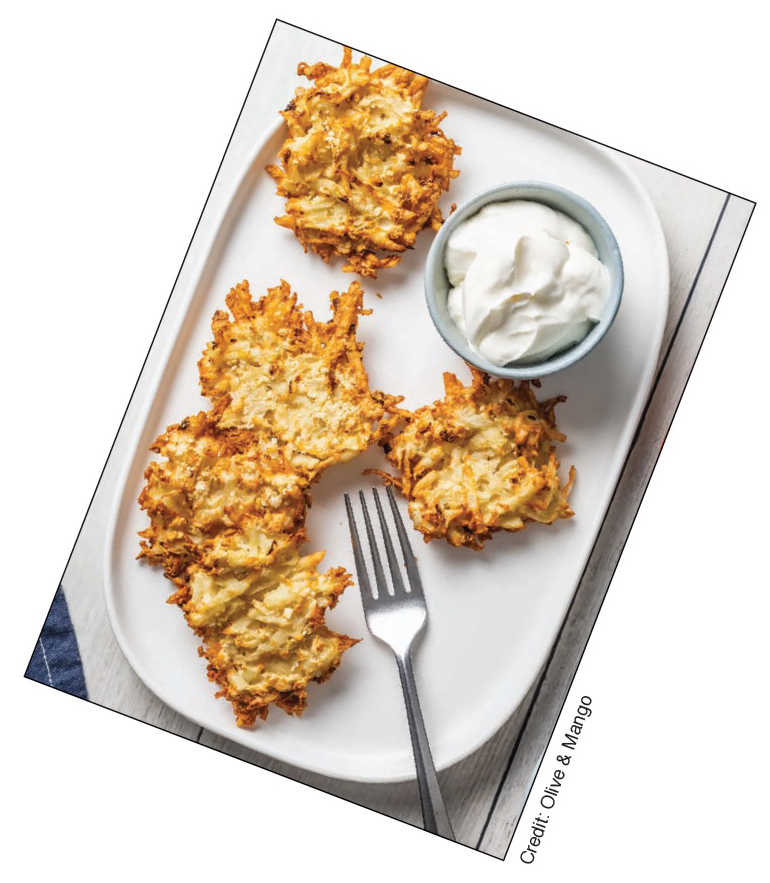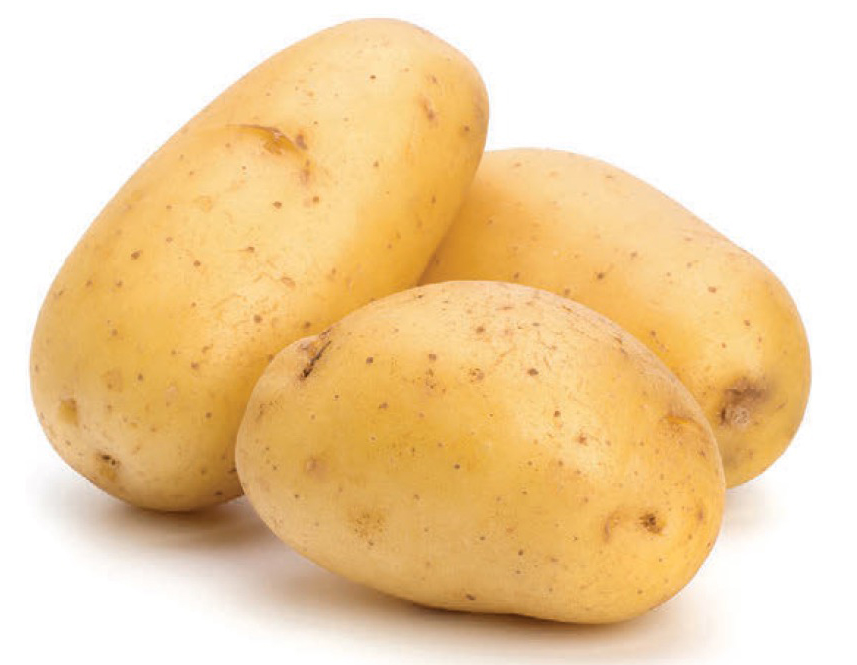
Whether it’s for a holiday or a family celebration, gathering around the table with relatives makes for a memorable occasion. It may be one of the few times you get together with your extended family. This year, explore your family’s roots and record a treasured family recipe.
On this page, learn about genealogy and find some healthier versions of traditional dishes to add to your holiday menu.
See the family tree and recipe activity on page 12.
 Air Fryer Latkes
Air Fryer Latkes
Recipe from thekitchn.com
Ingredients:
- 1½ pounds russet potatoes—approximately 2 or 3 potatoes
- ½ medium yellow onion
- 2 large eggs
- ¼ cup matzo meal
- 2 teaspoons kosher salt
- ½ teaspoon freshly ground black pepper
- cooking spray
Garnishes: sour cream, apple sauce
 Latkes Directions:
Latkes Directions:
Step 1: Peel potatoes. Have a parent help grate the potatoes and onion on the large holes of a box grater. Place together on a clean kitchen towel, pull up the sides of the towel to form a bundle, and squeeze out excess moisture.
Step 2: Transfer the potato mixture to a large bowl. Add 2 large eggs, 1/4 cup matzo meal, 2 teaspoons kosher salt, and 1/2 teaspoon black pepper, and stir to combine.
Step 3: Preheat Air Fryer Oven to 375ºF and set to 16 minutes*. Coat the air fryer rack with cooking spray. Drop the latke mixture in 2-tablespoon dollops into the air fryer, flattening the tops to make a patty. Spray the tops of the latkes with cooking spray. Air fry, turning the latkes halfway through cooking time. Repeat with the remaining latke mixture.
Step 4: Serve with sour cream and applesauce. Enjoy!
*Times may vary depending on your air fryer.
Easy Chicken Pozole
Recipe from allrecipes.com
 Ingredients:
Ingredients:
- 2 ½ pounds skinless, boneless chicken breast halves
- 4 tablespoons vegetable oil, divided
- 1 onion, chopped
- 3 cloves garlic, minced
- 2 ½ quarts chicken broth
- 3 cups water
- 1 teaspoon crumbled dried oregano
- 2 teaspoons salt
- 4 tablespoons chili powder, or to taste
- 3 cups white hominy, rinsed and drained
- 10 tostada shells
Garnishes: shredded cabbage or lettuce, sliced radishes, lime wedges, chopped onion & cilantro
Pozole Directions:
Step 1: Heat 2 tablespoons of canola oil in a deep skillet over medium-high heat. Add chicken breasts, and cook until no longer pink and juices run clear, about 20 minutes. Remove from skillet, drain, and cool. When completely cooled, shred chicken with a fork.
Step 2: Heat the remaining 2 tablespoons of canola oil in the same skillet over medium-high heat. Cook and stir onion and garlic until soft and transparent, about 5 minutes. Return shredded chicken to the skillet. Stir in the chicken broth, water, oregano, salt, and chili powder. Reduce heat to low, cover, and cook for about 90 minutes. Stir in the hominy and cook until tender, about 15 minutes more. Taste to adjust seasonings, adding more salt and chili powder, if desired. Serve in soup bowls with one tostada shell per serving. Garnish as desired.
 Nut & Fruit Salad
Nut & Fruit Salad
Ingredients:
- 1 cup or more of your favorite fresh fruits (blueberries, raspberries, strawberries, mandarin oranges, apples)
- 1/3 cup of dried fruit (dried cranberries, golden raisins, etc.)
- ¼ cup of nuts (slivered almonds, walnut pieces, pecan pieces)
- 1 head of green leaf or romaine lettuce, or 3 to 4 cups spinach or kale
 Directions:
Directions:
Step 1: Wash and pat dry or spin dry lettuce or greens. Tear into bite-size pieces and put in a large bowl.
Step 2: Wash and drain fresh fruit. Small berries can be added whole. Cut larger fruit into slices or chunks and add to salad.
Step 3: Add nuts and lightly toss all ingredients together with a dressing of your choice (try a light, sweet dressing like raspberry vinaigrette or poppy seed).
Learn About Your Amazing Family Tree!
Do you and your family have some unique traditions or stories that you share during the holidays? Do the smells of certain foods filling the house mean anything to you? Are there certain objects (HEIRLOOMS) that your family brings out?
Learning where those traditions come from is part of finding your roots! And the holidays are the perfect time of year to discover your family tree. To help, we’ve put together some tips, including a form on the next page to get you started!
“It’s really important to know why we do things in certain ways. Especially with family holidays, a lot is through food,” points out Genevieve Leavitt, who loves doing genealogy research for guests at Canyon Ranch and lectures on DNA tests.
 GENEALOGY is the study of families, their history, and the tracing of their lineages. Genealogists do family interviews, find historical documents and photos, and use DNA tests to help people connect to their roots. “It’s so much fun!” Leavitt says.
GENEALOGY is the study of families, their history, and the tracing of their lineages. Genealogists do family interviews, find historical documents and photos, and use DNA tests to help people connect to their roots. “It’s so much fun!” Leavitt says.
Family members getting together in person or virtually provides an opportunity to learn about your ancestors, family stories, and traditions. “You’re basically a product of your ancestors. Some people are lucky enough to know their grandparents or their great grandparents,” Leavitt points out. Try to interview the oldest in your family, and record things on video, tape recorder or just use pen and paper. Go for a simple story—ask how they used to celebrate at their house, what foods they cooked, etc. Also, remember to ask where! The place is an important part of your roots. And your interview needn’t be limited to the holidays. “There are just so many cool stories,” she says.
Use the form on the next page or print one of the many free ones that are online. “The best way to start is to put yourself first, then you put your dad, then your mom. Fill out the chart and you’ll see that you have blanks,” Leavitt says. Filling in those gaps is part of the challenge and requires digging a little deeper!
Technology has made filling out your family tree much more convenient. You and your family can find a wealth of information for free at FamilySearch.org, and the National Archives with U.S. Census, immigration, and military records is at archives.gov.
Leavitt says DNA testing has been a real game-changer in finding your roots. And as more people are added to these companies’ databases, the more refined the results are getting. The basic test costs around $100, but you can wait for sales. The two biggest are AncestryDNA and 23andMe, which maintain separate databases and come up with slightly different results.
And DNA companies say that 3–5 percent of those tested will get unexpected results. Genealogy clients can get confused. “They’ll say, ‘oh, I was told I’m part Native American or I’m part this or part that,’ and they get their DNA test and it’s not there,” Leavitt explains. “(For your) DNA, you get half from your mom and half from your dad. That (also) means that you didn’t get half from your mom and you didn’t get half from your dad. But your siblings can also get different halves, and some of the same. So it’s important to test not just yourself, but also your siblings!”










